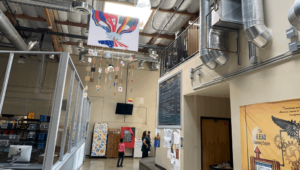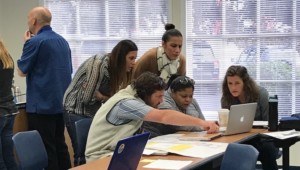5 Professional Learning Practices for PBL

By Dr. Katie Martin
Have you ever left a staff meeting, PLC or any other professional development session wondering what the purpose of the time together was, still unclear about what is expected of you?
Unfortunately, you are not alone. I frequently hear about schools or districts who are “doing project-based learning,” yet when I talk to teachers they aren’t sure what is expected of them and how the new methods align with previous expectations and policies.
When districts implement new project-based learning initiatives without creating opportunities for administrators and teachers to understand the goal or the underlying pedagogy, teachers often get mixed messages and lack necessary support to make the desired shifts a reality in their classrooms. We need to empower teachers, value their opinions and recognize their professional learning preferences.
Start with Teachers’ Preconceptions and Learning Preferences
We have to realize that teacher’s beliefs, knowledge and skills are shaped by their experiences both past and present, and that these often get mirrored in their classrooms. To ensure that the desired change to authentic, project-based learning environments has the desired impact on how students learn in school, we have to change how teachers learn.
I have been asking teachers across diverse schools, districts and states what they feel they need to be successful in shifting their practices and designing learning experiences to meet the needs of all students. Teachers consistently tell me they want their professional learning to include the following five characteristics:
1. Development of a Shared Understanding of the Vision and Expectations. Teachers (like all learners) thrive when they have a clear understanding of the vision and know where they are going, yet have the autonomy to get there in a way that meets the needs of the students in their classrooms. Teachers want to have a clear picture of the desired learning environment and clearly understand the expectations related to their role to ensure their students are successful today, tomorrow and in their distant future. With a clear purpose and goal, educators can leverage a wide variety of resources and experts both in schools and across the global community to continually improve practice.
2. Opportunities to be Learners. Learning through exploration or a deep dive into a project or challenge is an inherently different learning experience than planning for how to create a project or hearing about what project-based learning should look like. Teachers want opportunities to engage in projects in order to understand the obstacles and opportunities that learners face when engaging in these types of learning experiences. Through this experience and reflection, teachers often gain key insights into how personal circumstances, resources, connections and motivation impact their learning, and become more cognizant of how to better design project-based learning experiences in their own classrooms.
3. Access to High-Quality Examples of Desired Model of Teaching and Learning. Exploring models can inspire teachers to create and build on existing projects that others have created. When this is done in collaborative groups, educators can not only gain ideas from the models, but also benefit from the experience and expertise of their colleagues as well. Creating new projects from scratch can be overwhelming. When models exist, teachers build on the foundations and adapt or integrate other ideas to meet the needs of their unique context.
When models exist, teachers build on the foundations and adapt or integrate other ideas to meet the needs of their unique context. Additionally, utilizing protocols such as the Looking at Student Work Protocol can help facilitate a thoughtful process in order to go beyond the project plan and delve into student work to analyze and reflect on the impact of the desired learning experiences.
4. Opportunities to Observe Teaching and Learning. Teachers have been far too isolated and the teaching profession is plagued by a culture of closed doors. When given the opportunity (and sometimes a gentle nudge), teachers appreciate observing peers and reflecting on their own practice and almost always want to do it more. There is value in observing peers both to develop a shared understanding of what learning and teaching look like in a teacher’s own context and to determine next steps.
In addition, visiting and connecting with other schools is extremely important. When teachers have access to other teachers in different contexts, they see new approaches and possibilities that exist beyond their own classroom and school.
5. Engagement in Job-Embedded Collaboration. Teachers like to learn from their peers, and seek regular collaborative learning opportunities during the work day. When these effective systems are in place for all teachers, they often learn new strategies and increase their effectiveness and efficacy through the collective knowledge and support of the learning community. Teachers regularly suggest the following structures be embedded in the work day to facilitate their growth and development:
- Communities of inquiry to find and solve problems together
- Differentiated opportunities to choose based on comfort, skills or context
- Collaboration with teams or departments
Moving Forward
Creating diverse opportunities for professional learning is more important than ever as many schools strive to move away from standardization to more personalized environments for all learners. Ensuring that teachers have opportunities to develop a shared vision, engage as learners, access resources and materials, observe models of the desired teaching and learning, and collaborate with peers in more authentic and personal ways are critical to shifting to more authentic, project-based learning.
In the end, though, I hope you don’t just take my word for it. I keep asking teachers what they need to meet the needs of the learners in their classroom and I hope you will too.
|
This blog is part of “It’s a Project-Based World” series. To learn more about this series and to learn ways that you can contribute, click the icon below to go to the Project-Based World page. Join in the conversation at #projectbased. |
For more, see:
- Passionate + Flexible = Key Traits of Great PBL Teachers
- Preparing Teachers for Project-Based Learning
- Teaching is a Project-Based Profession: 10 PBL Teacher Mindsets
- Project-Based Teaching: The Untamed Spaces of Innovation
Dr. Katie Martin is the Director of Professional Learning at University of San Diego’s Mobile Technology Learning Center. Follow her on Twitter here: @KatieMTLC
Stay in-the-know with all things EdTech and innovations in learning by signing up to receive the weekly Smart Update.






Michelle Wright
Thank you for this article. Number one on your list particularly resonates with me and the teachers I work with. Could you share an example or two of schools who have done a good job articulating their visions and how PBL aligns with other frameworks? We are currently struggling with exactly this problem. Many thanks for any advice you can share.